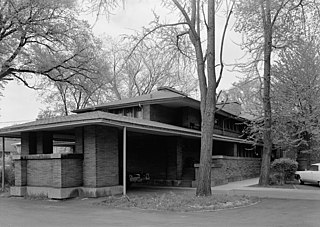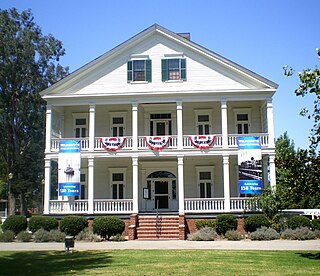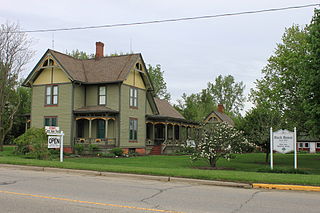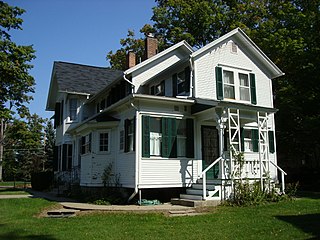
The Darwin D. Martin House Complex, also known as the Darwin Martin House National Historic Landmark, was designed by Frank Lloyd Wright and built between 1903 and 1905. Located at 125 Jewett Parkway in Buffalo, New York, it is considered to be one of the most important projects from Wright's Prairie School era, and ranks along with The Guggenheim in New York City and Fallingwater in Pennsylvania among his greatest works.

The Victorian Village District is an area of Memphis, Tennessee.

The Villa Louis is a National Historic Landmark located on St. Feriole Island, in Prairie du Chien, southwestern Wisconsin. The villa and estate are a historical museum operated by the Wisconsin Historical Society. The site has been restored to its appearance during the late 19th century, when it was the estate of the prominent H. Louis Dousman family, descendants of a fur trader and entrepreneur.

The Ellwood House was built as a private home by barbed wire entrepreneur Isaac Ellwood in 1879. It is located on First Street in DeKalb, Illinois, United States, in DeKalb County. The Victorian style home, designed by George O. Garnsey, underwent remodeling in 1898-1899 and 1911. The house was originally part of 1,000 acres (4 km²) which included a large stable complex known as "Ellwood Green." Isaac Ellwood lived here until 1910 when he passed the estate to his son, Perry Ellwood.

The Liberty Hall Museum, located in Union, Union County, New Jersey, United States, is an American historic site. Built in 1772 as a fourteen-room Georgian-style house, Liberty Hall stands today a fifty-room Victorian Italianate mansion. Liberty Hall has been home to many historical figures and was the home of William Livingston, the first Governor of New Jersey, who served from 1776 to 1790; United States Supreme Court Justice Henry Brockholst Livingston; the Kean political dynasty, including Susan Livingston Kean, widow of Continental Congress delegate John Kean, United States Senator and Congressman John Kean, and Captain John Kean, son of United States Senator Hamilton Fish Kean; and, in its first year of occupancy, future Treasury Secretary Alexander Hamilton. Liberty Hall has had visitors of such stature as George Washington, Martha Washington, Lewis Morris, Marquis de Lafayette, Elias Boudinot, and John Jay, the latter of whom was married there.

Banning House, also known as the General Phineas Banning Residence Museum, is a historic Greek Revival-Victorian home in the Wilmington section of Los Angeles, California. Built in 1863 by Phineas Banning near the original San Pedro Bay, it remained in the Banning family until 1925 and has been owned by the City of Los Angeles since 1927. The home, barn and gardens are now operated as a museum. The Banning House property, also known as Banning Park, has been designated as a city Los Angeles Historic-Cultural Monument and state California Historical Landmark and has been federally listed on the National Register of Historic Places.

Belfield, also known as the Charles Willson Peale House, was the home of Charles Willson Peale from 1810 to 1826, and was declared a National Historic Landmark in 1965. The Belfield Estate was a 104-acre (42 ha) area of land in the Logan section of Philadelphia, Pennsylvania, much of which is now a part of La Salle University’s campus.

Rose Hill Manor, now known as Rose Hill Manor Park & Children's Museum, is a historic home located at Frederick, Frederick County, Maryland. It is a 2 1⁄2-story brick house. A notable feature is the large two-story pedimented portico supported by fluted Doric columns on the first floor and Ionic columns on the balustraded second floor. It was the retirement home of Thomas Johnson (1732–1819), the first elected governor of the State of Maryland and Associate Justice of the United States Supreme Court. It was built in the mid-1790s by his daughter and son-in-law.

The Rensselaer D. Hubbard House, is a historic house in Mankato, Minnesota. Originally a private home, it is currently a museum. The building was placed on the National Register of Historic Places on June 7, 1976.

The Carl E. and Alice Candler Schmidt House is a private home located at 301 Lake Shore Rd. in Grosse Pointe Farms, Michigan. It was listed on the National Register of Historic Places in 2005. Built in 1904, the house is one of the oldest remaining properties in the Grosse Pointes to have a view of Lake Saint Clair.

The Banfill Tavern, also known as the Locke House, is a historic building in Fridley, Minnesota, United States. It was built in 1847 on the east bank of the Mississippi River and has served variously as an inn, a logging camp office, a private home, a dairy farm, a post office, and a summer home. It is now owned by Anoka County and houses the non-profit Banfill-Locke Center for the Arts. The building stands within Manomin County Park, and the art center is a partner site of the Mississippi National River and Recreation Area.

The Comstock House is a historic house museum in Moorhead, Minnesota, United States. It was built for Solomon Comstock and his family from 1882 to 1883 in a mix of Queen Anne and Eastlake style. Comstock (1842–1933) was one of Moorhead's first settlers and an influential figure in business, politics, civics, and education in the growing city and state.

Promont is a historic house in Milford, Ohio, United States, which was built in 1865 and listed on the National Register of Historic Places in 1980. It was home to John M. Pattison, 43rd Governor of Ohio from 1879 until his death in 1906.

The Friend–Hack House, also known as the Hack House, was built as a private house, located at 775 County Street in Milan, Michigan. It was listed on the National Register of Historic Places in 1991, and currently houses the Hack House Museum.

The Mann House is a historic home located at 205 Hanover Street in Concord, Michigan. It is a Michigan State Historic Site and is listed on the National Register of Historic Places. It has been operated as a museum since 1970.

The Schnull–Rauch House, sometimes referred to as the Victorian Manor and now also branded as The Manor at The Children's Museum of Indianapolis, is a National Register of Historic Places-designated Romanesque Revival historic home constructed in the early 20th century at 3050 North Meridian Street, north of downtown Indianapolis, Indiana.

The Cotton-Smith House is a historic house at 42 High Street in Fairfield, Maine. Built in 1890, it is one of Fairfield's finest Queen Anne Victorian houses. It was built by Joseph Cotton, owner of the Maine Manufacturing Company, which produced iceboxes, and occupied by him for just four years. The house was acquired in 1983 by the Fairfield Historical Society, which operates it as the Fairfield History House, a museum of local history. The house was listed on the National Register of Historic Places in 1992.

The Brightman House is a historical house in Millersburg, Ohio first built in 1902. The house is now owned by the Holmes County Historical Society and operated as the Victorian House Museum, with displays of Victoriana and Holmes County history.

The Waterloo Farm Museum is a museum located at 9998 Waterloo-Munith Road in Waterloo Township, Michigan. It was originally the Siebold Farm and then the Realy Farm. The farm was listed on the National Register of Historic Places in 1973.





















